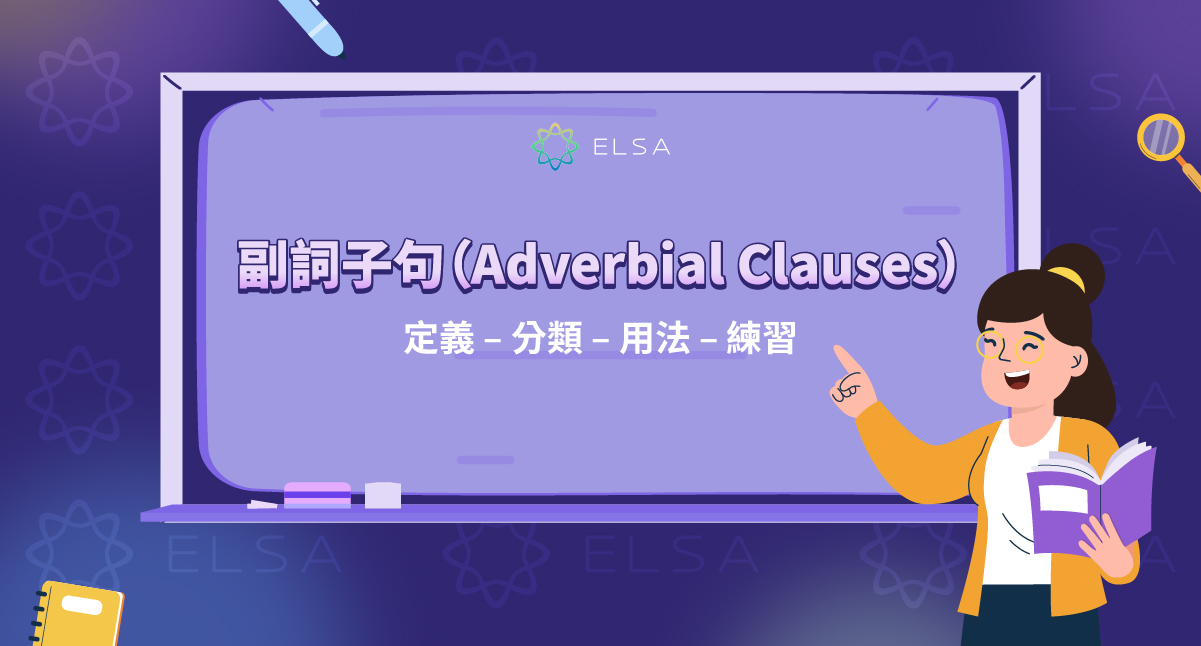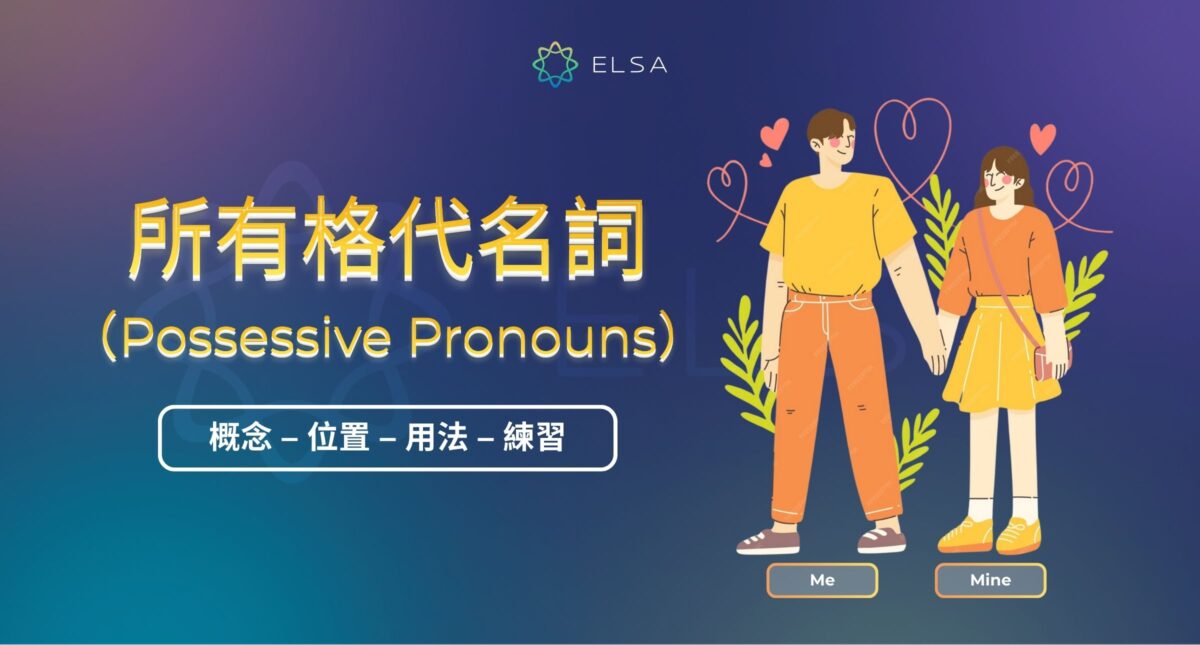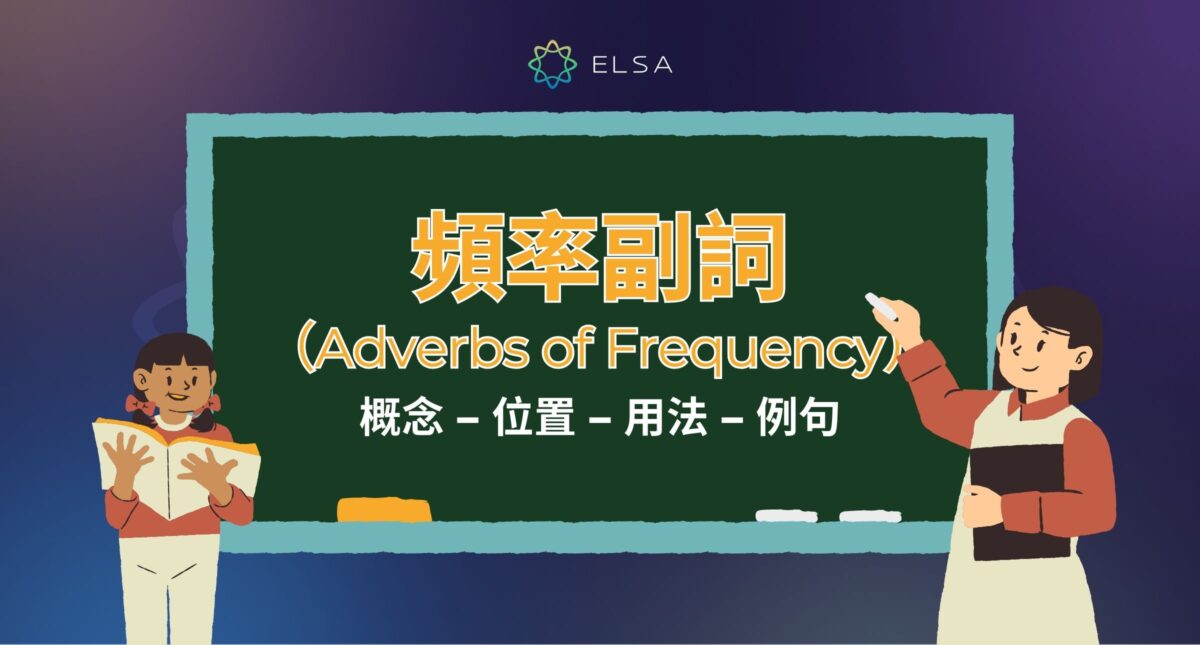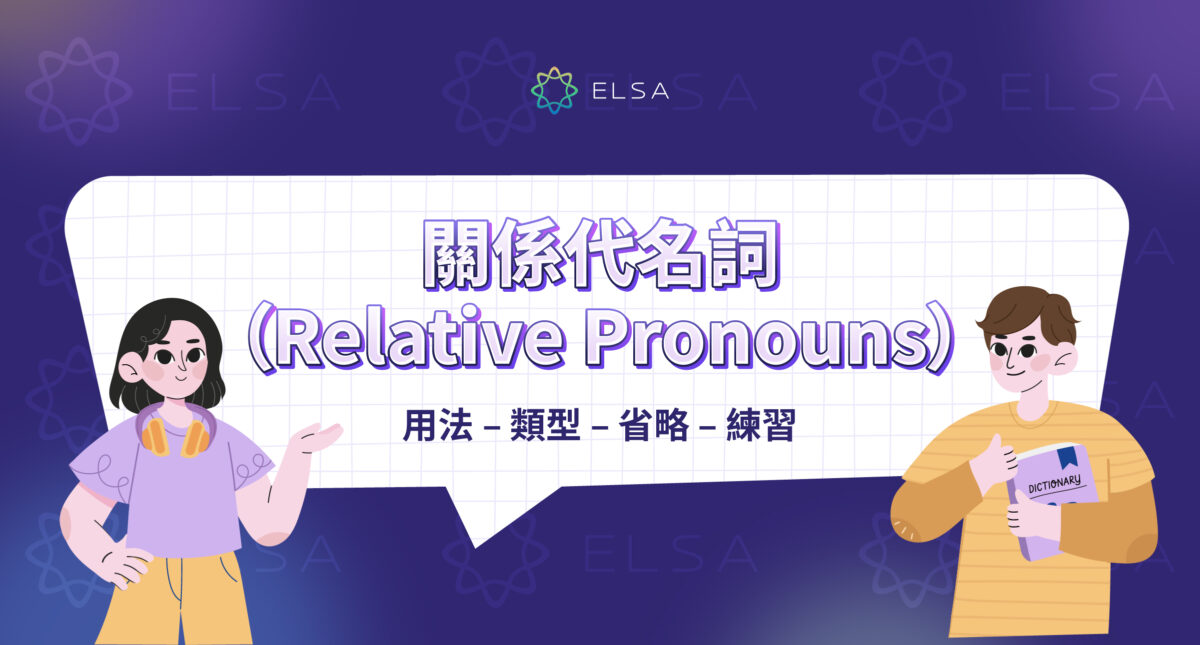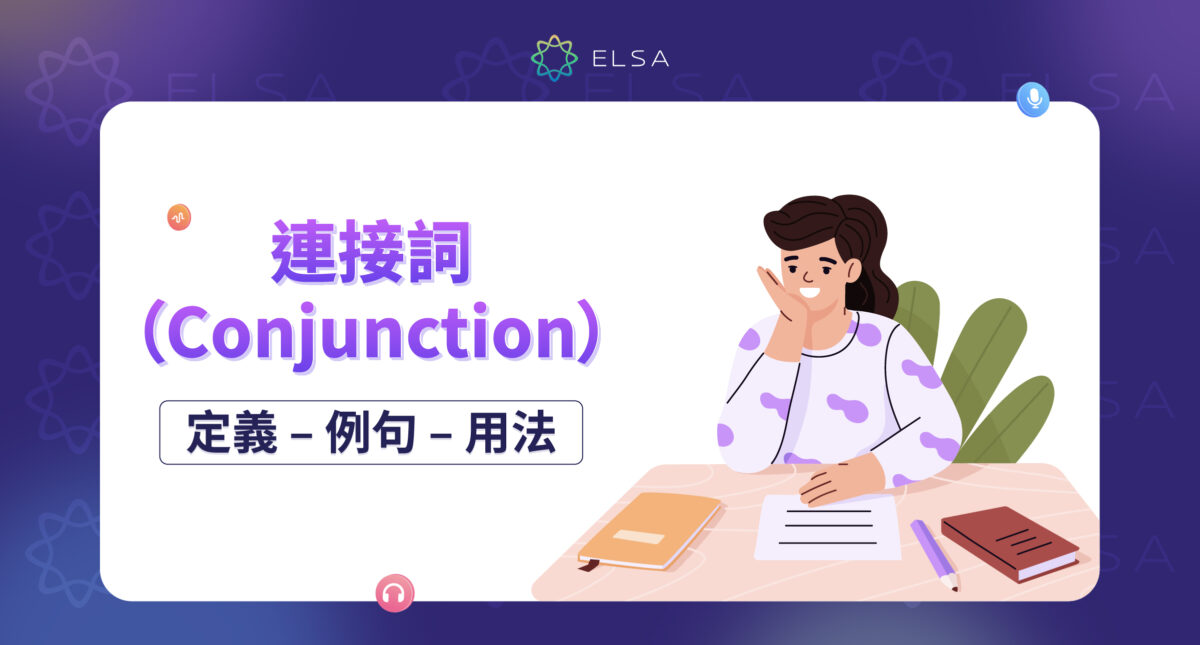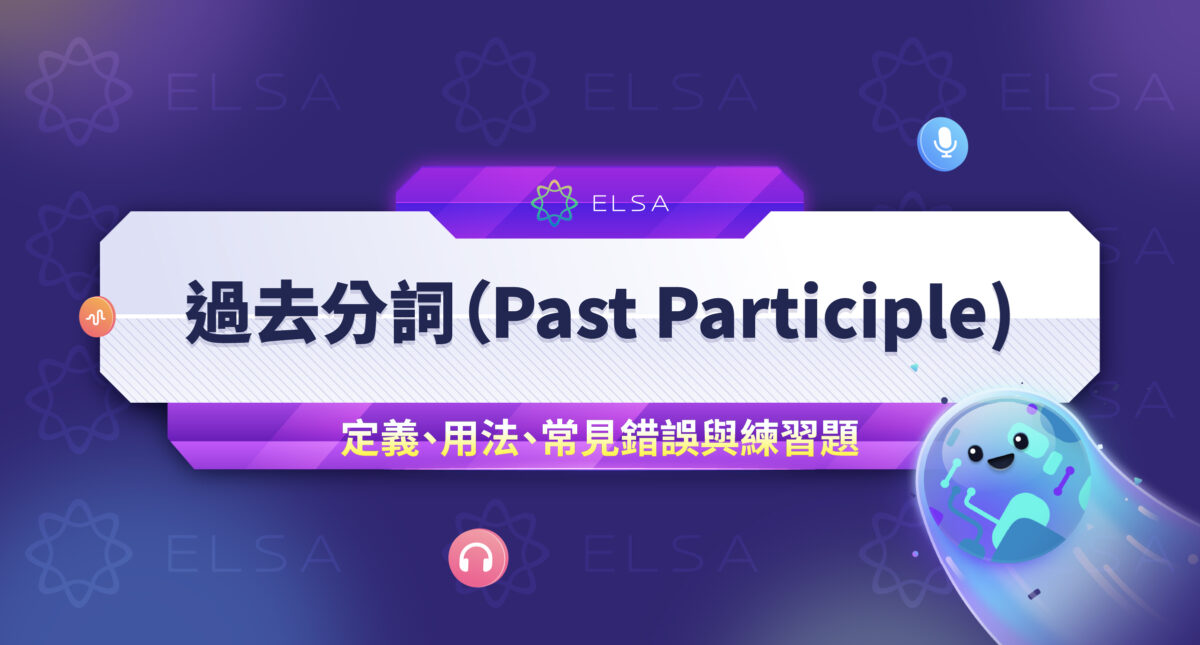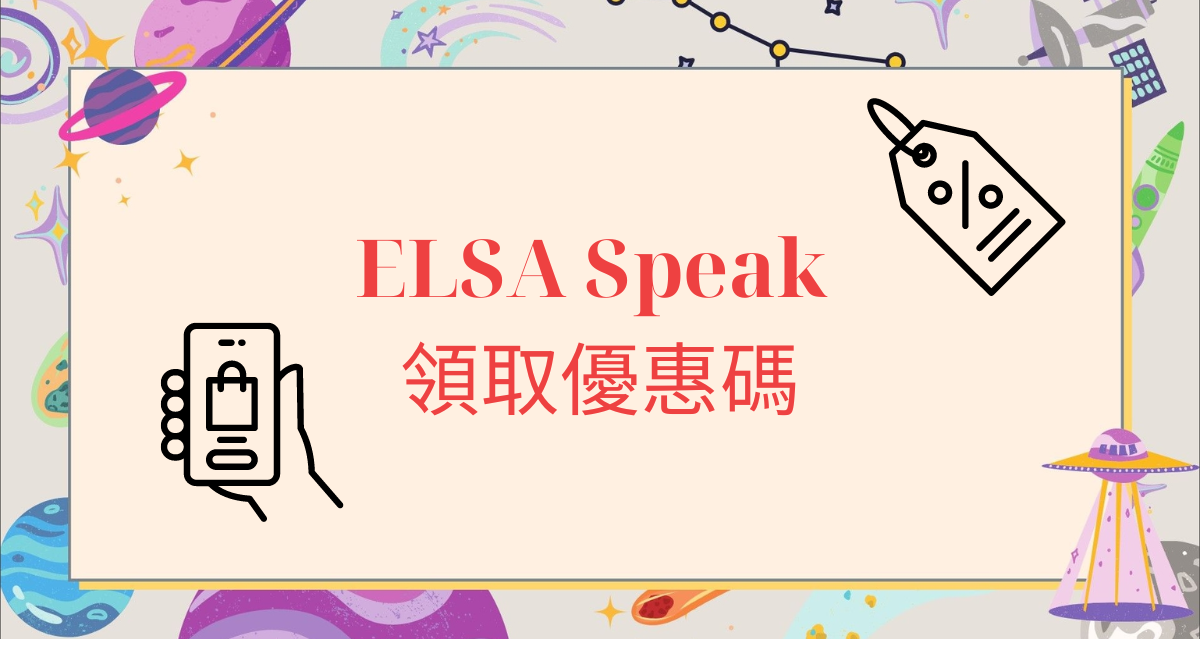當學習英文文法時,你肯定曾聽說過「形容詞子句」與「名詞子句」。雖然這是兩個非常重要的文法部分,但許多學習者仍無法清楚區形容詞子句名詞子句差別,或者常常混淆 how、that 的使用,尤其在需要簡化關係代名詞時也容易出錯。本文中,ELSA Speak 將協助你全面掌握相關概念:從關係子句、限制性與非限制性子句,到如何用分詞來簡化形容詞子句,並附上實戰練習題幫助你更熟練。
| Key takeaways: – 形容詞子句 用來修飾名詞 (也就是 “先行詞”) 。 + 關係代名詞: who, whom, whose, which, that + 關係副詞: when, where, why + 限制性子句: 沒有逗號,為句子必要資訊 + 非限制性子句: 有逗號,提供額外補充說明 – 簡化形容詞子句: 若關係代名詞是受詞,且子句中已有主詞,可省略該關係代名詞。 |
形容詞子句是什麼?
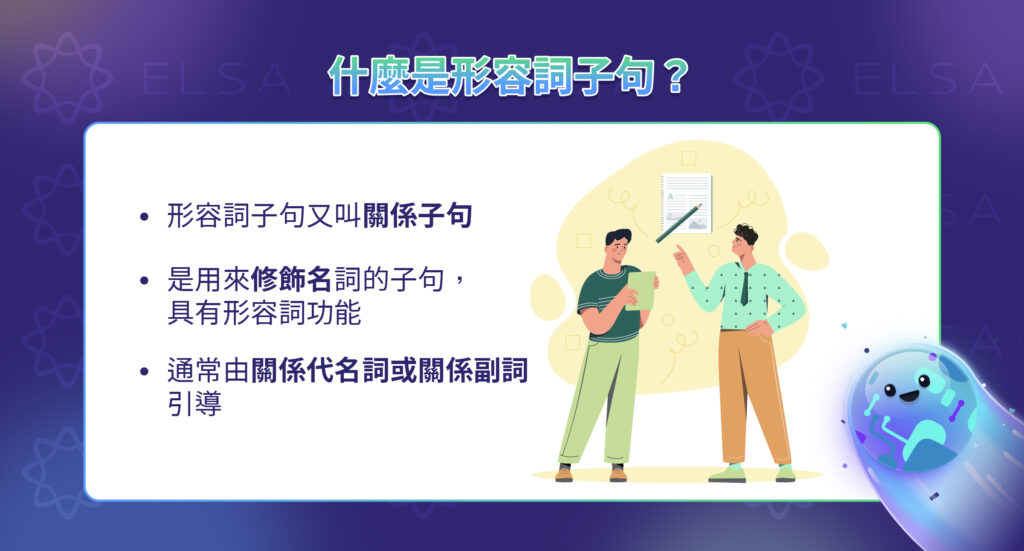
形容詞子句英文為 Adjective Clause,又稱為關係子句,是一種從屬子句,用來描述或修飾名詞,在句中起到形容詞的作用。形容詞子句通常以關係代名詞開頭,如 that、which 或 who。
例句:
- Jack caught a fish, which was gigantic! (傑克釣到了一條超級大的魚。)
➞ “which was gigantic” 是形容詞子句, 用來修飾名詞 “Fish”。
- The guy who lives next to my house is a painter. (住在我家旁邊的那個人是一位畫家。)
➞ “who lives next to my house” 是形容詞子句, 用來修飾主語 “The guy”。
>>閲讀更多:所有關於八種英文詞性:用法、例子及在句子中的位置
形容詞子句的分類
根據“被替代的詞”(也稱為“先行詞(antecedent)”),我們可以將形容詞子句分為兩大類:使用關係代名詞的子句與使用關係副詞的子句。
關係代名詞 形容詞子句
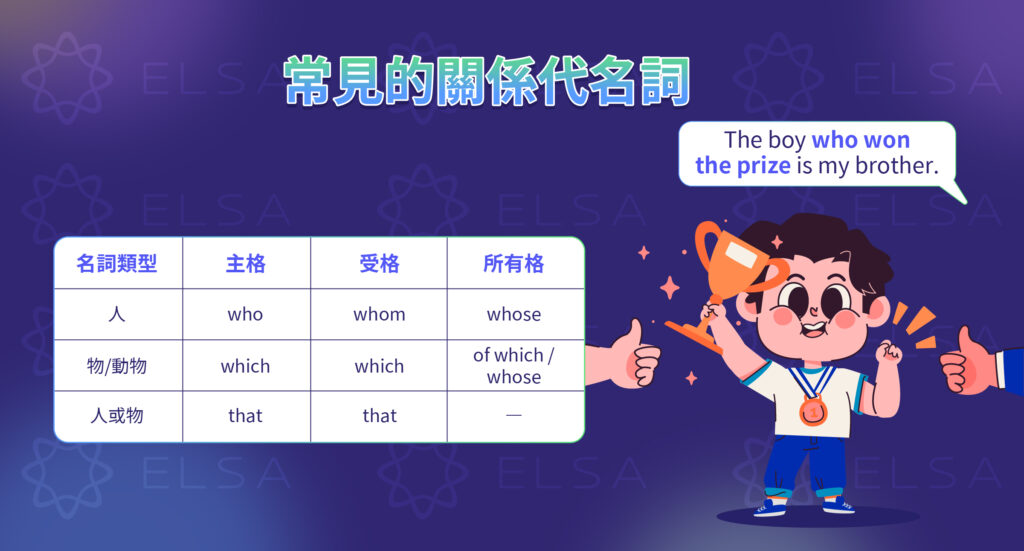
常見的關係代名詞如下: who, whom, whose, which, that, 用於代替已經提到的人、物或事件。
| 對象(先行詞) | 主格(主語) | 受格(受詞) | 所有格 |
|---|---|---|---|
| 人 | who | whom | whose |
| 物/動物 | which | which | whose / of which |
| 人 + 物 (混合) | that | that | — |
例子:
- He is a cruel kid who kills animals without blinking an eye。
→ “kid” 是人,且作主詞 → 使用 who。
- He is the one whom Lily has a secret crush on。
→ “the one” 是人,作受詞 → 使用 whom (可以省略若前面沒有介詞)。
- I know the girl whose first name is Woods。.
→ “the girl”是人,且擁有 “first name” → 使用 whose。
- I really treasure the watch which you gave me on my birthday。
→ “the watch” l是物,作受詞 → 使用 which。
- The book that I borrowed from the library is very interesting。
→ “the book” 是物,作受詞 → 使用 that 代替 which。
注意: 關係代名詞 who, whom, which 都可以用 that 來代替 除了whose之外。

關係副詞 形容詞子句
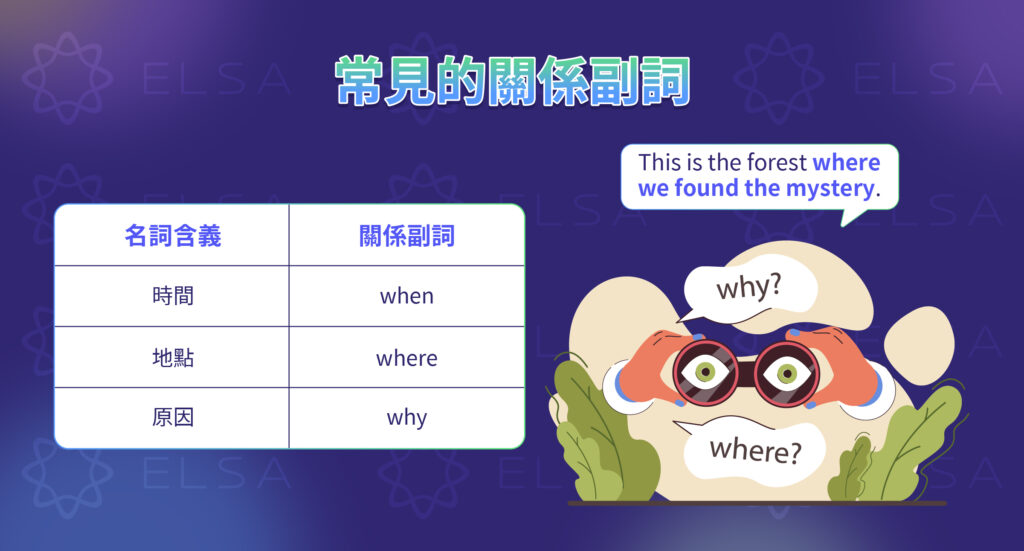
若先行詞是表示時間、地點或原因的名詞,則使用關係副詞: when, where, why。
| 先行詞(名詞) | 使用的關係副詞 |
|---|---|
| 表示時間 | when |
| 表示地點 | where |
| 表示原因 | why |
例子:
- I will never forget the day when I first met you。
→ “the day” 是時間 → 使用 when。
- This is the coffee shop where we first met。
→ “the coffee shop” 是地點 → 使用 where 引導形容詞子句。
- I think that’s the main reason why she left you。
→ “the main reason” 是原因 → 使用 why。
形容詞子句的用法
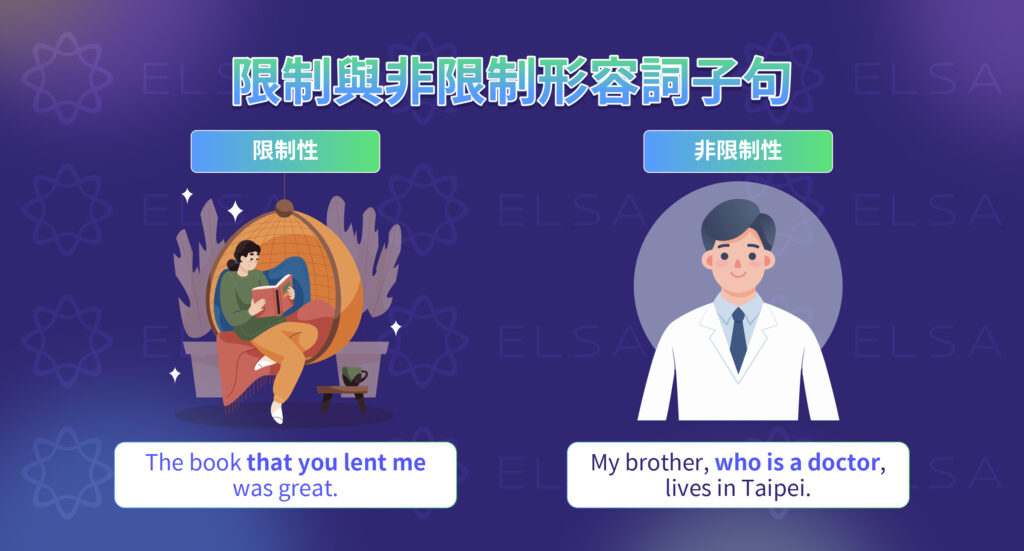
從前面的內容中我們已經了解,形容詞子句(Adjective Clause)在句中起到修飾名詞的作用——使句意更加明確與具體。然而,根據補充資訊的重要程度,形容詞子句可分為兩種:形容詞子句限定非限定,我們來區分這兩種形容詞子句分詞構句吧!
形容詞子句限定 (Restrictive Adjective Clause)
這類子句是必要的資訊,用來明確指稱先行詞的意思。若省略此子句,句子雖然語法正確,但語意將變得不清楚,讓聽者或讀者無法理解具體是誰或是什麼。
特點:
- 不使用逗號。
- 無法省略,否則意思會不完整。
例子: I will never forget the day when I first met you.
(我永遠不會忘記第一次遇見你的那一天。)
→ 若省略 “when I first met you”, 剩下的句子是 “I will never forget the day.” – 聽起來非常模糊,無法確定是哪一天。
形容詞子句非限定 (Non-restrictive Adjective Clause)
此類子句屬於額外補充資訊,不必要,即使省略也不影響整句話的主體意思。通常以逗號與主句分開,表示該子句為附加說明。
特點:
- 必須用逗號隔開。
- 不能使用 that 作為關係代名詞。
- 對句子的主要意思不是必要的資訊。
例子: Johnny Depp, who played the role of Captain Jack in the movie Pirates of the Caribbean, is coming to the premiere next month. (Johnny Depp – 曾在神鬼奇航中飾演傑克船長 – 將於下月出席首映。)
→ 若省略 “who played the role…”, 句子仍然完整明確: “Johnny Depp is coming to the premiere next month。”
>>閲讀相關:冠詞 a、an、the 是什麼?初學者如何輕鬆地掌握冠詞用法?
形容詞子句 省略方式
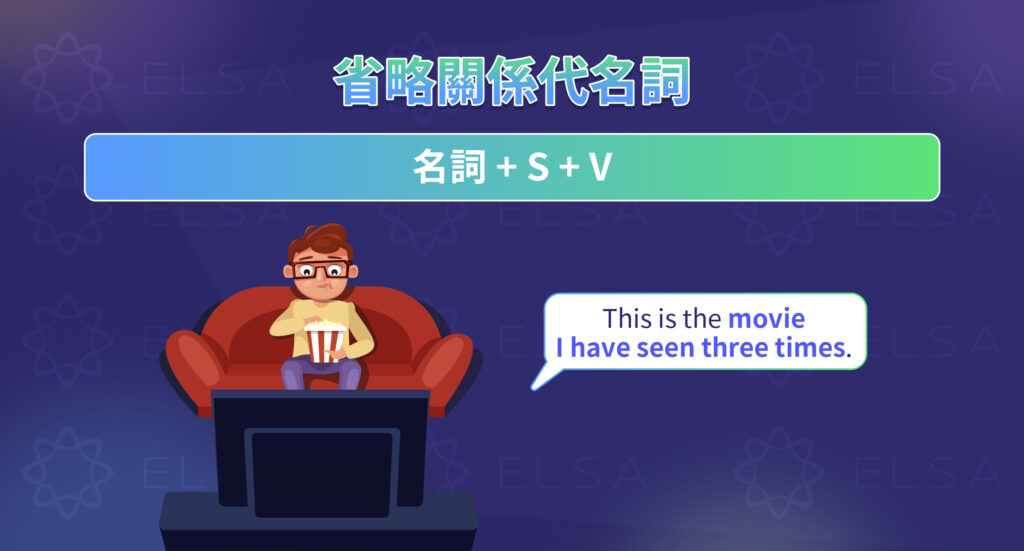
句子太長了怎麽辦?來學習一下形容詞子句 簡化方式吧。在形容詞子句中,關係代名詞常常可以被省略, 判斷方法:
- 當關係代名詞是受詞 (whom, which, that)
- 在關係代名詞之後有完整的主詞
公式:
| 名詞(先行詞) + 關係代名詞 + S + V → 名詞 + S + V |
例子:
- This is the book that I was talking about. (我正在說的是那本書。)
= This is the book I was talking about.
- This is the movie which I have seen three times. (那部電影我已經看了三次。)
= This is the movie I have seen three times.
什麼情況下不能省略關係代名詞?若關係代名詞本身是子句的主詞,則不能省略。
無法省略的例子:
- I met someone she dated in high school. (錯)
- I met someone whom she dated in high school – 我遇見了那個曾在高中時和她約會過的人。(對)
小技巧:
- 若關係代名詞後面是動詞 ➞ 不能省略關係代名詞。
- 若關係代名詞後面是名詞 ➞ 可以省略關係代名詞。
>>閲讀更多:被動語態是什麽?探索公式、結構和註釋以及應用練習,以避免混淆
區分形容詞子句與其他相似語法結構
形容詞子句名詞子句差別
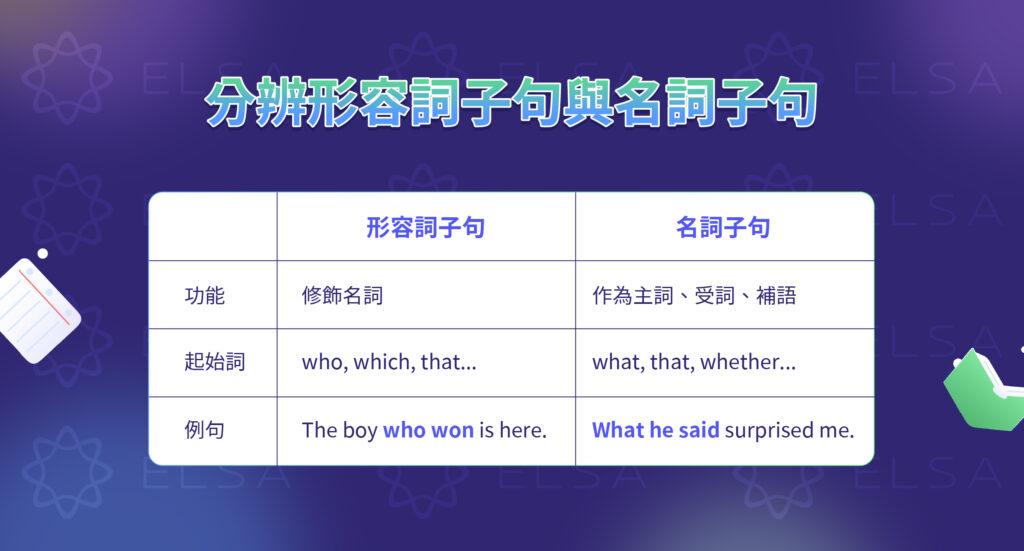
| 形容詞子句 | 名詞子句 | |
|---|---|---|
| 功能 | 修飾名詞 | 在句中作主詞、受詞或補語 |
| 位置 | 緊接在所修飾的名詞之後 | 位置較靈活:位於句首、動詞或介系詞之後 |
| 開頭 | who, whom, whose, which, that, when, where | that, what, who, whether, if, how, why… |
| 動詞結構 | 有 | 有 |
| 例句 | The boy who won the prize is my friend. (得獎的那個男孩是我朋友。) | What he said surprised me. (他說的話讓我很驚訝。) |

區分形容詞子句 形容詞片語

| 形容詞子句 | 形容詞片語 | |
|---|---|---|
| 功能 | 修飾名詞 | 也修飾名詞 |
| 結構 | 具有主詞與動詞 (完整子句) | 無主詞,通常是 V-ing/V-ed phrase |
| 簡化子句 | 可以簡化成片語 | 是簡化形式或較簡短的描述方式 |
| 例句 | The girl who is wearing red is my sister. (那位穿紅衣的女孩是我妹妹。) | The girl wearing red is my sister. (穿紅衣的女孩是我妹妹。) |
區分形容詞子句 同位語
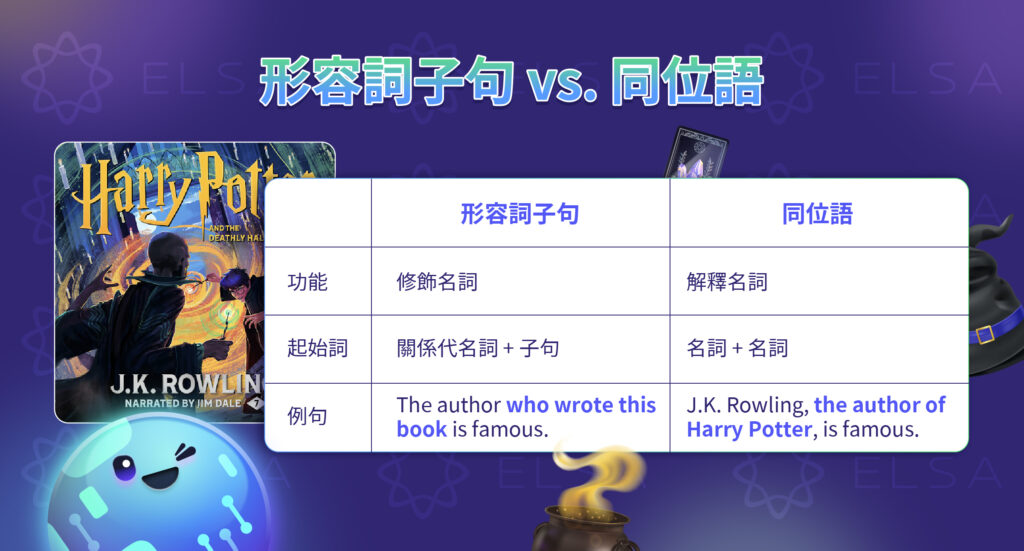
| 形容詞子句 | 同位語 | |
|---|---|---|
| 功能 | 修飾名詞 | 解釋或說明前面的名詞 |
| 判斷標誌 | 有關係代名詞 + 動詞 | 兩個名詞並列,沒有連接詞 |
| 動詞結構 | 有 | 沒有 |
| 例句 | The author who wrote this book is famous. (寫這本書的作者非常有名。) | J.K. Rowling, the author of Harry Potter, is famous. (J.K. Rowling,哈利波特的作者,非常有名。) |
>>更多語法結構:
形容詞子句練習題
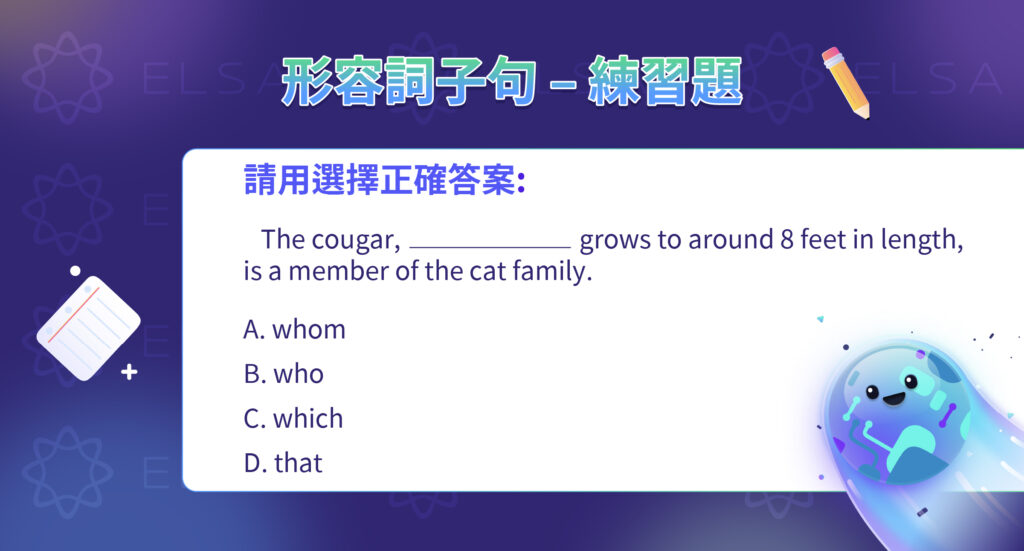
練習題
練習題 1: 運用形容詞子句知識改寫句子:
- The man was sick. He looked very pale.
- He was sitting in the emergency room. It was very crowded.
- A nurse was nearby. He called her.
- The nurse called a doctor. She came quickly.
- The doctor asked him to lie down. She looked very worried.
練習題 2: 選出正確答案:
1. The cougar, ______ grows to around 8 feet in length, is a member of the cat family.
A. whom
B. who
C. which
D. that
2. Cougars sometimes prey on sheep and goats, so they may be killed by the farmers ______ animals they attack.
A. which
B. whom
C. who
D. whose
3. The cougar has powerful legs, ______ it uses to climb and to jump into trees.
A. which
B. whom
C. who
D. whose
4. The cougar lives in deserts, forests, plains and mountains, but according to scientists ______ have studied the animal, it is becoming endangered in some areas.
A. whom
B. which
C. who
D. whose
5. However, cougars very rarely attack humans, of ______ they are usually afraid.
A. who
B. whom
C. which
D. that
6. The town ______ we visited last summer was very beautiful.
A. where
B. which
C. who
D. whose
7. The woman ______ car was stolen called the police.
A. which
B. who
C. whom
D. whose
8. That’s the house ______ I was born.
A. where
B. which
C. whom
D. that
9. The boy ______ is standing over there is my cousin.
A. whom
B. which
C. who
D. where
10. I don’t like people ______ talk too loudly in public.
A. whom
B. which
C. who
D. whose
答案
練習題 1:
- The man, who was sick, looked very pale.
- He was sitting in the emergency room, which was very crowded.
- He called a nurse, who was nearby.
- The nurse called a doctor, who came quickly.
- The doctor, who looked very worried, asked him to lie down.
練習題 2:
| 題號 | 1 | 2 | 3 | 4 | 5 |
| 答案 | C. which | D. whose | A. which | C. who | B. whom |
| 題號 | 6 | 7 | 8 | 9 | 10 |
| 答案 | B. which | D. whose | A. where | C. who | C. who |
深入理解形容詞子句與名詞子句,不僅能幫助你掌握英文語法,還能提升你的學術寫作能力與專業溝通技巧。別忘了經常練習,試著將形容詞子句簡化為分詞構句,並反覆練習區分限制性與非限制性子句,才能真正掌握這一語法要點。若你想進一步學習更多英語文法主題,歡迎造訪 ELSA Speak 官方網站,學習更高效,發音更道地,如同母語人士!

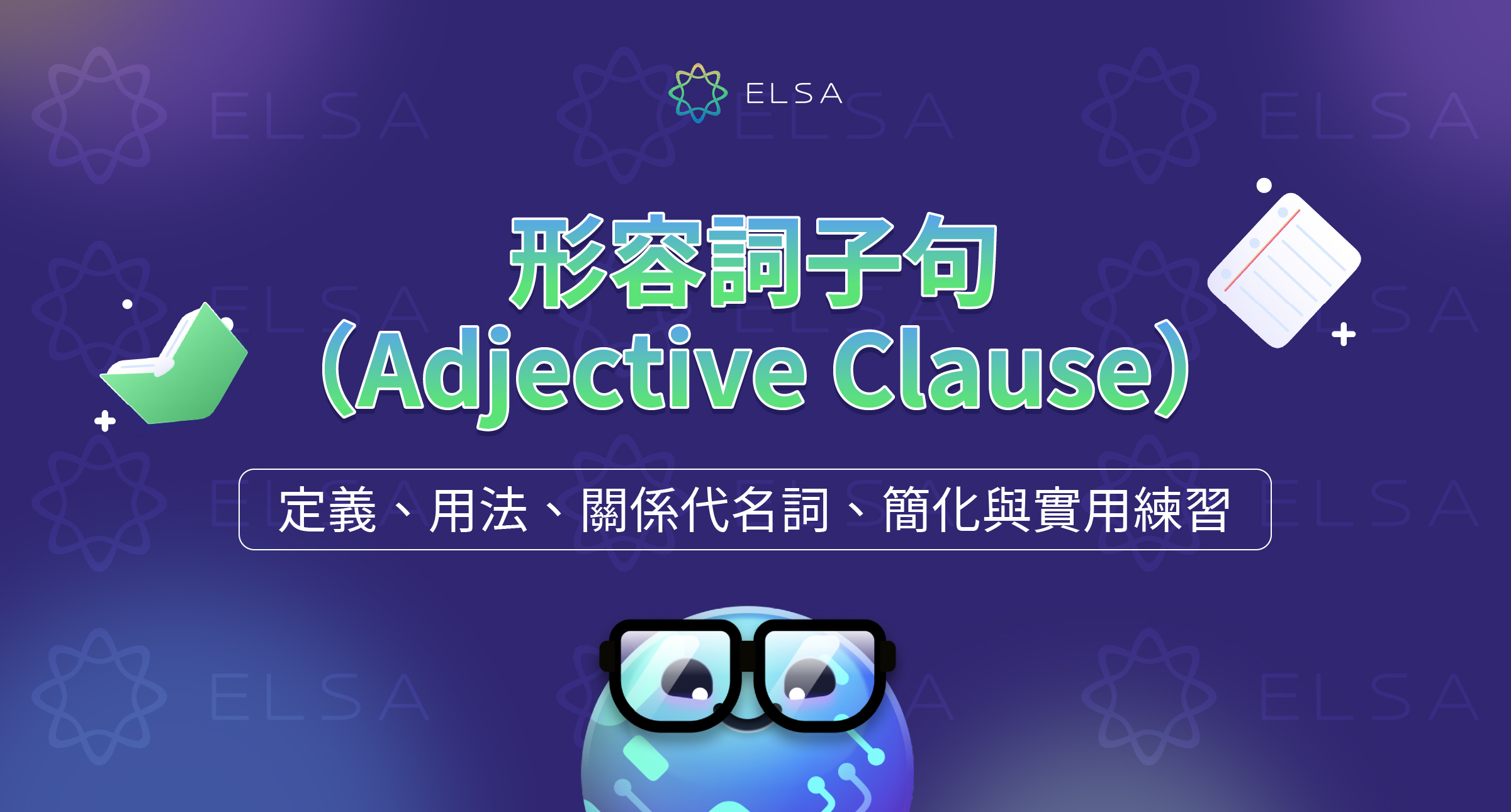
 2025年/07月/09日 | 魚丸
2025年/07月/09日 | 魚丸